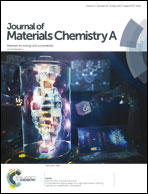Design and synthesis of integrally structured Ni3N nanosheets/carbon microfibers/Ni3N nanosheets for efficient full water splitting catalysis†
Abstract
The relatively poor electrical conductivity of metal nitrides and the low density of their utilizable active sites have continually restricted their catalytic abilities for the oxygen evolution reaction (OER) and hydrogen evolution reaction (HER) for highly efficient water splitting. Herein, for the first time, we report the design and synthesis of a novel three-dimensional (3D) hierarchically meso-macroporous and hollow tube-like architecture of Ni3N nanosheets/carbon microfibers/Ni3N nanosheets (Ni3N/CMFs/Ni3N) assembled by the dispersion of porous Ni3N nanosheets (NSs) over the inner and outer walls of hollow and porous CMFs. Benefitting from excellent electrical conductivity and a high density of utilizable active sites, Ni3N/CMFs/Ni3N revealed superior OER and HER catalytic activities compared with Ni3N supported by graphene (Gr), carbon nanotubes (CNTs) and macroporous carbons (MPCs), respectively. In O2-saturated 1.0 M KOH, the OER potential at 10 mA cm−2 [E10, 1.50 V vs. RHE] and the Tafel slope (41.54 mV dec−1) of Ni3N/CMFs/Ni3N were both lower than those of RuO2 [1.53 V vs. RHE and 43.45 mV dec−1, respectively]. Also, the HER E10 value of Ni3N/CMFs/Ni3N [−0.115 V (vs. RHE)] was only 40 mV larger than that of commercial Pt/C [−0.075 V (vs. RHE)] in N2-saturated 1.0 M KOH. For full water splitting, to achieve a current density of 20 mA cm−2 (E20) in O2-saturated 1.0 M KOH, the (−) Ni3N/CMFs/Ni3N‖Ni3N/CMFs/Ni3N (+) electrolysis cell required a cell voltage of only 1.652 V, which is only 19 mV larger than that of the state-of-the-art (−) Pt‖RuO2 (+) benchmark (1.633 V). In addition, due to the remarkable structural and chemical stabilities of Ni3N/CMFs/Ni3N, especially the unique protection of ∼2 to 3 layers of graphite carbon shells (GCSs) on the Ni3N nanoparticles (NPs) in Ni3N/CMFs/Ni3N, the Ni3N/CMFs/Ni3N-based water electrolysis cell also displayed excellent stability. The novel conceptual double surface catalysis model of Ni3N/CMFs/Ni3N, which was assembled by the dispersion of porous Ni3N nanosheets (NSs) over the inner and outer walls of hollow and porous CMFs, is an exciting new direction for the rational design and fabrication of porous nanomaterials for electrochemical energy and sensing applications.



 Please wait while we load your content...
Please wait while we load your content...